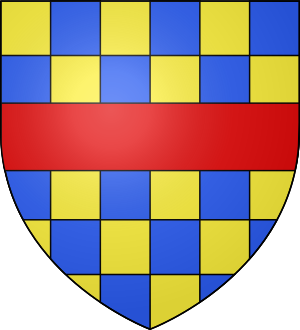Robert Clifford, 1st Baron Clifford facts for kids
Quick facts for kids
Robert de Clifford
|
|
|---|---|

Arms of Clifford: Chequy or and azure, a fesse gules, recorded by the heralds as having been borne by him in the Caerlaverock Roll of 1300
|
|
| Born | 1 April 1274 Clifford Castle, Herefordshire, England. |
| Died | 24 June 1314 (Died at the Battle of Bannockburn) Bannockburn, Stirlingshire, Scotland. |
| Title | Baron de Clifford |
| Tenure | 1299 – 24 June 1314 |
| Other titles | Lord of Skipton |
| Nationality | English |
| Residence | Appleby Castle Brougham Castle Skipton Castle |
| Spouse(s) | Maud de Clare |
| Issue | Roger de Clifford, 2nd Baron de Clifford Idonia de Clifford, Baroness Percy Robert de Clifford, 3rd Baron de Clifford Margaret de Clifford, Lady Mauley |
| Parents | Roger de Clifford Isabella de Vipont |
|
|
|

Robert de Clifford (born April 1, 1274 – died June 24, 1314) was an important English soldier and nobleman. He lived during the time of Kings Edward I and Edward II. Robert de Clifford was the first person to hold the title of Baron de Clifford. He was also known for being the first Lord Warden of the Marches, a very important job where he was in charge of protecting England's border with Scotland. He owned several castles, including Appleby Castle and Skipton Castle.
Contents
Robert de Clifford's Early Life
Robert de Clifford was born at Clifford Castle in Herefordshire, England. His father was named Roger de Clifford, and his mother was Isabella de Vipont. Robert's family was very old and important. His grandfather, also named Roger, was a powerful landowner.
Family History and Lands
Robert's mother, Isabella, came from another strong family called the Viponts. They owned many lands and castles, including Appleby Castle and Brougham Castle in Westmorland. When Robert's father passed away before his own father, Robert became the main heir. This meant he would inherit his grandfather's lands.
Becoming a Powerful Landowner
In 1286, Robert inherited his grandfather's estates. Later, in 1291, when his mother, Isabella, died, he inherited half of the large Vipont lands. This included important castles like Appleby Castle and Brougham Castle.
Brougham Castle's Role
Brougham Castle became a key military base for Robert. This was especially true when the Wars of Scottish Independence began in 1296. Even King Edward I of England visited Brougham Castle in 1300, showing how important it was. In 1308, Robert gained even more land from his aunt, Idonea de Vipont. This made him one of the wealthiest and most powerful noblemen in England.
Robert de Clifford's Military Career
Robert de Clifford was a skilled soldier who served both King Edward I and King Edward II. He played a big part in the wars against Scotland.
Fighting in Scotland
In 1296, Robert was sent to Scotland with another nobleman, Henry de Percy, 1st Baron Percy, to stop the Scots. He was then made the Governor of Carlisle, a key city near the Scottish border.
Warden of the Marches
Robert was given the important job of Warden of the Marches. This meant he was responsible for defending the border between England and Scotland. He was the very first person to hold this official title.
Key Battles and Achievements
In 1298, Robert fought bravely for King Edward I at the Battle of Falkirk. In this battle, the famous Scottish leader William Wallace was defeated. For his bravery, Robert was rewarded with the job of Governor of Nottingham Castle.
In 1299, Robert was given the title of Baron de Clifford. This meant he was officially a nobleman and could be called to advise the King in Parliament.
He also gained great fame at the Siege of Caerlaverock Castle in 1300. During this siege, his family's coat of arms (a shield with gold and blue squares and a red stripe) was recorded in a famous poem called the Caerlaverock Roll. The poem praised his wisdom, strength, and noble character.
Serving King Edward II
After King Edward I died in 1307, Robert de Clifford became an important advisor to the new king, Edward II. He was even made Marshal of England for a short time. This role meant he helped organize important events, like King Edward II's coronation ceremony in 1308.
In 1310, King Edward II gave Robert de Clifford Skipton Castle and made him Lord of Skipton. Skipton Castle later became the main home for the Clifford family for many years.
Conflict with Piers Gaveston
In 1312, Robert de Clifford joined other powerful noblemen, like Thomas, Earl of Lancaster, in opposing Piers Gaveston. Gaveston was a close friend of King Edward II, and many nobles felt he had too much power. Robert de Clifford helped to surround Gaveston at Scarborough Castle.
Marriage and Family
In 1295, Robert de Clifford married Maud de Clare at Clifford Castle. Maud was the daughter of Thomas de Clare, Lord of Thomond. Robert and Maud had four children together:
- Roger de Clifford, 2nd Baron de Clifford (born 1300)
- Idoine (or Idonia) de Clifford (born around 1303), who married Henry de Percy, 2nd Baron Percy.
- Robert de Clifford, 3rd Baron de Clifford (born 1305)
- Margaret de Clifford (born 1307), who later married Piers de Mauley.
Death and Burial
Robert de Clifford died fighting bravely at the Battle of Bannockburn on June 24, 1314. He was killed during a cavalry charge against Scottish soldiers. He was buried at Shap Abbey in Westmorland.


